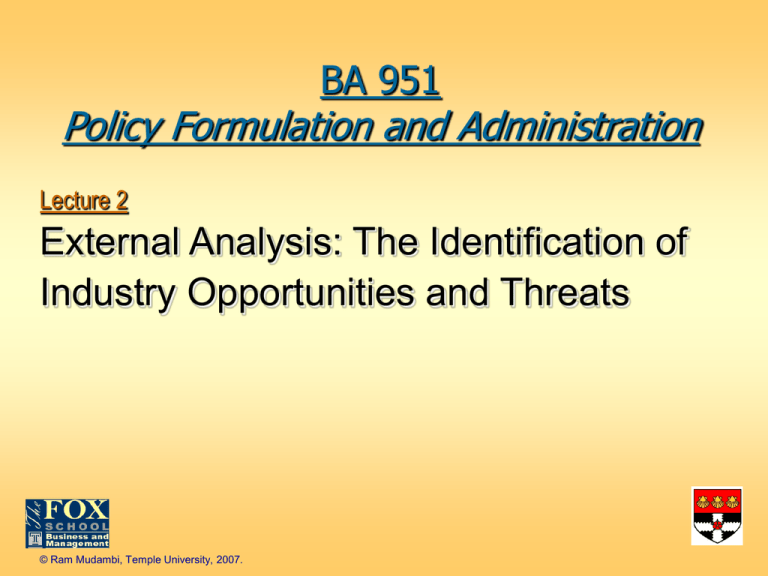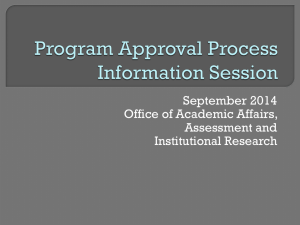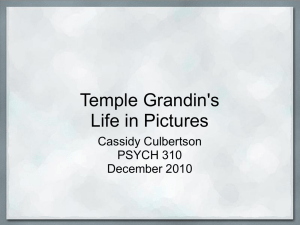
BA 951
Policy Formulation and Administration
Lecture 2
External Analysis: The Identification of
Industry Opportunities and Threats
© Ram Mudambi, Temple University, 2007.
Learning Outcomes
Methodologies for analyzing the external
environment of the firm
Theories
Applications
European groceries
Competition in a digital age
© Ram Mudambi, Temple University, 2007.
2-2
Lecture Outline
Components of External Analysis
Static models for examining external environment
The Industry - The Five Forces Model
Wide Focus – PEST Analysis
Narrow Focus – Strategic Groups
Dynamic models – industry evolution
Punctuated equilibrium
The life cycle model
The external environment and Network economies
Globalization
The competitive advantage of the Nation State
© Ram Mudambi, Temple University, 2007.
2-3
Two Components of External Analysis
Supplying a viable,
saleable product
ANALYSIS OF PRODUCT
Ability to survive
its environment
ANALYSIS OF ENVIRONMENT
KEY
SUCCESS FACTORS
© Ram Mudambi, Temple University, 2007.
2-4
Analysis of Product: What are the
industry’s dominant economic traits?
Market size and growth rate
Scope of competitive rivalry
Number of competitors and their relative sizes
Prevalence of backward/forward integration
Entry/exit barriers
Nature and pace of technological change
Product and customer characteristics
Scale economies and experience curve effects
Capacity utilization and resource requirements
Industry profitability
© Ram Mudambi, Temple University, 2007.
2-5
Defining an Industry
Industry
A group of companies offering products or services that are close
substitutes for each other and that satisfy the same basic customer
needs
Industry boundaries may change as customer needs evolve and
technology changes
Sector
A group of closely related industries
Market Segments
Distinct groups of customers within an industry
Can be differentiated from each other with distinct attributes and
specific demands
© Ram Mudambi, Temple University, 2007.
2-6
The Computer Sector: Industries and
Market Segments
© Ram Mudambi, Temple University, 2007.
2-7
Analyzing Industry Structure
Opportunities and threats are competitive
challenges arising for changes in industry
conditions.
The five forces model is
an analytic tool that helps
managers formulate
appropriate strategic
responses.
© Ram Mudambi, Temple University, 2007.
2-8
Porter’s Five Forces Model
Potential entrants
Bargaining power
of suppliers
4
Suppliers
1
Bargaining power
of buyers
Threat of new entrants
2
3
Industry competitors
Rivalry amongst existing firms
Buyers
Threat of new substitute product
or service
5
Substitutes
Source: Adapted and reprinted by permission of Harvard Business
Review. An exhibit from “How Competitive Forces Shape Strategy”
by Michael E.. Porter (March-April 1979), Copyright © 1979 by the
President and Fellows of Harvard College: all rights reserved.
© Ram Mudambi, Temple University, 2007.
2-9
Competitive Strategy
Industry environment
Five forces model
The firm
Distinctive competencies
vis-à-vis competitors
Strategic Choice
Maximize
competitive advantage
© Ram Mudambi, Temple University, 2007.
2-10
Potential Entrants
FORCE 1
• Joe Bain’s key insight – firm profitability is
affected by extant competition as well as
potential competition.
• Firms limit their current
profits for fear of attracting
entrants.
•Entry barriers reduce the threat
of new and additional competition.
© Ram Mudambi, Temple University, 2007.
2-11
Barriers to entry - Bain vs. Stigler
‘Barriers to entry’ is a loaded term
Joe Bain (U.C.-Berkeley) - barriers to
entry exist when entrant firms face
obstacles
George Stigler (U.Chicago) - barriers
to entry exist when entrant firms face
obstacles not faced by incumbent firms
© Ram Mudambi, Temple University, 2007.
2-12
“Barriers to entry” - Bain
•
Economies of scale
• Existence of learning/experience curve effects
• Strong brand preferences and customer loyalty
• Capital requirements and/or other specialized resource
requirements
• Cost disadvantages independent of size
• Access to distribution channels
All these are barriers according to Bain, but not
according to Stigler. Entrant firms just have to follow the
same path of incumbents
© Ram Mudambi, Temple University, 2007.
2-13
Barriers to entry - Stigler
All of the above “barriers” would be called
first-mover advantages by Stigler. However,
Stigler does agree that there are barriers to
entry. Some examples:
• Inability to gain access to specialized
technology - patents are barriers
• Regulatory policies, tariffs, trade restrictions
- legal restrictions are barriers
© Ram Mudambi, Temple University, 2007.
2-14
Rivalry Among Established Companies
FORCE 2
The intensity of competitive rivalry in an
industry arises from:
Industry’s competitive structure.
Demand (growth or decline) conditions in industry.
Height of industry exit barriers.
© Ram Mudambi, Temple University, 2007.
2-15
Competitive Structure
Continuum of
Industry Structures
Fragmented
Many firms,
no dominant
firm
© Ram Mudambi, Temple University, 2007.
Few firms,
shared dominance
(oligopoly)
Consolidated
One firm or one
dominant firm
(monopoly)
2-16
The Market Spectrum
Inter-dependence
irrelevant
Inter-dependence
absent
Real World Market Structures
Perfect Monopolistic
Oligopoly
Competition Competition Homogeneous Heterogeneous
Firms
Infinite
Many
Few
Few
Product Identical Differentiated Homogeneous Heterogeneous
Mkt Pwr
None
Little
Strong
Very strong
Entry
Substantial Substantial &
None
Low
barriers
reinforced
Commodities
Stock
Gas stations,
E.g.s
– oil, coffee, Autos, FMCGs
market
restaurants
tea
Increasing deadweight loss
© Ram Mudambi, Temple University, 2007.
Monopoly
Regulated Pure
One
No close substitute
Regulated Perfect
Legal Blockaded
Utilities
-
2-17
The Bargaining Power of Buyers
FORCE 3
Buyers are most powerful when:
There are many small sellers and few large buyers.
Buyers purchase in large quantities.
A single buyer is a large customer to a firm.
Buyers can switch suppliers at low cost.
Buyers purchase from multiple sellers at once.
Buyers can easily vertically integrate to compete with
suppliers.
© Ram Mudambi, Temple University, 2007.
2-18
The Bargaining Power of Suppliers
FORCE 4
Suppliers have bargaining power when:
Their products have few substitutes and are important
to buyers.
The buyer’s industry is not an important customer to
the supplier.
Differentiation makes it costly for buyers to switch
suppliers.
Suppliers can vertically integrate forward to compete
with buyers and buyers can’t integrate backward to
supply their own needs.
© Ram Mudambi, Temple University, 2007.
2-19
Substitute Products
FORCE 5
The competitive threat of substitute products
increases as they come closer to serving
similar customer needs.
Far
© Ram Mudambi, Temple University, 2007.
Close
2-20
A Sixth Force: Complementors
Complementors:
Companies whose products are sold in tandem with
another company’s products.
Increased supply of a complementary product
collaterally increases demand for the primary product.
Example:
Faster CPU chips fuel sales
of personal computers.
© Ram Mudambi, Temple University, 2007.
2-21
Who profits from falling transaction
costs?
Complementor
Complementary Assets
Imitability
Primary
Assets
Freely available
Tightly held
or unimportant
and important
High 1. Difficult to make
Low
Firm 1
© Ram Mudambi, Temple University, 2007.
2. Money made on
money
complementary assets
3. Money made on
4. Bargaining power
primary assets
determines outcome
Firm 2
Market
2-22
Example
Nokia makes cell phone bodies
Texas Instruments makes Digital Signal Processing
chips (DSPs) that make it possible for cell phones
to become web devices
Primary assets – Nokia’s cell phone technology
Complementary assets – TI’s DSP technology
Which cell does this fall into?
This is a generic example as more and more devices
become web-enabled, e.g., TVs, fridges, etc.
© Ram Mudambi, Temple University, 2007.
2-23
Generic Strategies
Complementary Assets
Imitability
Primary
Assets
High
Freely available
Tightly held
or unimportant
and important
1. RUN
2. Joint venture (JV),
alliance, acquisition
Low
3. BLOCK
4. BLOCK: JV,
alliance, acquisition
Run: continuously changing key elements of the business
model - continuous innovation
Block: Erect barriers to entry around existing business
model - making imitation costly (patents, brands, etc.)
© Ram Mudambi, Temple University, 2007.
2-24
Collaborative Advantage – Burton’s 5 sources
Previously unrelated industries
Relational contracting,
Prospective diversification
quasi-integration
alliances
Suppliers
Partnering w/
channels., buyers
Industry collaborators
Horizontal strategic alliances
Buyers
Related diversification alliances
Substitutes and complements
© Ram Mudambi, Temple University, 2007.
2-25
Collaborative Strategy
Industry environment
Five sources model
The firm
Distinctive competencies
vis-à-vis collaborators
Strategic Choice
Maximize
collaborative advantage
© Ram Mudambi, Temple University, 2007.
2-26
PORTER
BURTON
Five forces of competition
Five sources of collaboration
Firm’s distinctive competencies
Sustainable competitive
advantage
Sustainable collaborative
advantage
Composite strategy
Maximize overall sustainable advantage
© Ram Mudambi, Temple University, 2007.
2-27
The Role of the Macro-environment
Polity
Demography
Substitutes
Suppliers
Complements
INTERNAL
Operations
Finance
HRM
Marketing
Rivals
Society
© Ram Mudambi, Temple University, 2007.
Economy
Regulation
Buyers
Entrants
Technology
2-28
Wide-focus: PEST ANALYSIS
POLITY
ECONOMY
Nature of govt; Govt stability;
Business Cycles; GNP trends;
Freedom of Markets:
Interest rates; Money supply;
Monopolies; Environment
Inflation; Unemployment;
protection laws; Taxation
Disposable income; Energy
policy; Foreign trade
availability and cost
regulations; Employment law
SOCIETY
TECHNOLOGY
Population Demographics; Income
Govt spending on research;
distribution; Social mobility;
Industry focus on technology;
Lifestyle changes; Attitudes to
work, leisure and risk; Attitudes New discoveries/development;
Speed of technology transfer;
towards women, minorities,
Rates of obsolescence
immigration; Consumerism;
Levels of education
© Ram Mudambi, Temple University, 2007.
2-29
Strategic Groups Within Industries
The concept of strategic groups
Within an industry, a competitor grouping using
similar strategies that differ from other industry
groups.
Implications of strategic groups
The closest industry competitors are those in the
group.
The various industry groups are differentially and
competitively advantaged and positioned.
Mobility barriers inhibit the movement of competitors
from one strategic group to another.
© Ram Mudambi, Temple University, 2007.
2-30
Strategic Groups in the Pharmaceutical
Industry
© Ram Mudambi, Temple University, 2007.
2-31
Criticisms of the Five Forces and Strategic
Group Models
•Both models are static and ignore innovation.
•Their focus is on industry and group
structures rather than individual companies.
Innovation creates change in
industry structures, altering the
competitive environment.
Industry structure cannot
fully explain the performance
differences between industry
competitors.
© Ram Mudambi, Temple University, 2007.
2-32
Stasis
Punctuated
Equilibrium
and
Competitive
Structure
Major Innovation
Stasis
Development & Diffusion
© Ram Mudambi, Temple University, 2007.
2-33
The Industry Life Cycle Model
Stages in the industry life cycle:
© Ram Mudambi, Temple University, 2007.
2-34
Technology and the life cycle
Leaders – first movers
Fast followers – second
movers
Late followers – third
movers
© Ram Mudambi, Temple University, 2007.
Development
Competing standards
Diffusion
•Emergence of an industry
standard
•Network externalities
Imitation
Parallel
development
Adoption
Licensing &
royalties
2-35
Industry life cycle and industry
structure
Nascent Phase
• Many firms
• Competing techs/
standards
• Product is:
• Expensive
• User unfriendly
• Slow growth
© Ram Mudambi, Temple University, 2007.
Consolidation
• Mergers/Acquisitions/
Exits
• Development of single
standard
• Product is:
• Much cheaper
• User friendly
• Product R&D
• Rapid growth
Maturity TIME
• Mature
Oligopoly
• Intense
rivalry
• Process R&D
• Slow growth,
decline
2-36
Network Economics As a Determinant of
Industry Conditions
The demand for primary industry products
depends on the size of the total market for
complementary products.
Network economics result in
positive feedback loops that
foster rapid demand increases.
Market competitors are
protected by switching
cost entry barriers.
© Ram Mudambi, Temple University, 2007.
2-37
Positive Feedback in the Computer
Industry
© Ram Mudambi, Temple University, 2007.
2-38
Globalization and Industry Structure
Globalization
Globally dispersed production lowers
costs and increases quality.
Global markets are replacing
national markets.
Trend implications
No isolated national markets
More competitors, more intense competition
More rapid innovation and shorter product life cycles
© Ram Mudambi, Temple University, 2007.
2-39
The Internet – a powerful external stimulus
INTERNET
Globalizing
customers
Larger fixed costs
Dispersed, changing
technology
Shorter product
life-cycles
More uncertainty
Greater incentives for collaborative strategies
© Ram Mudambi, Temple University, 2007.
2-40
The Nation-State and Competitive
Advantage – Porter’s Diamond model
The determinants of competitive advantage:
Factor
endowments
© Ram Mudambi, Temple University, 2007.
2-41
Summary
Static models for analyzing the firm’s
external environment
The industry – 5 forces
Beyond the industry – PEST
Within the industry – strategic groups
Dynamic models
Punctuated equilibria and the industry life cycle
Drivers of the external environment
Networks, globalization, location advantages
© Ram Mudambi, Temple University, 2007.
2-42









